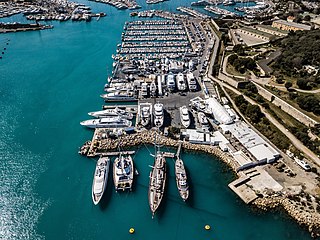Related Research Articles

The River Clyde is a river that flows into the Firth of Clyde in Scotland. It is the ninth-longest river in the United Kingdom, and the second or third longest in Scotland. It runs through the major city of Glasgow. Historically, it was important to the British Empire because of its role in shipbuilding and trade. To the Romans, it was Clota, and in the early medieval Cumbric language, it was known as Clud or Clut. It was central to the Kingdom of Strathclyde.

The Firth of Clyde is the mouth of the River Clyde. It is located on the west coast of Scotland and constitutes the deepest coastal waters in the British Isles. The firth is sheltered from the Atlantic Ocean by the Kintyre peninsula, which encloses the outer firth in Argyll and Ayrshire. The Kilbrannan Sound is a large arm of the Firth of Clyde, separating the Kintyre Peninsula from the Isle of Arran. Within the Firth of Clyde is another major island – the Isle of Bute. Given its strategic location at the entrance to the middle and upper Clyde, Bute played a vital naval military role during World War II.

Harland & Wolff is a British shipbuilding and fabrication company headquartered in London with sites in Belfast, Arnish, Appledore and Methil. It specialises in ship repair, shipbuilding and offshore construction. Harland & Wolff is famous for having built the majority of the ocean liners for the White Star Line, including Olympic-class trio – RMS Olympic, RMS Titanic and HMHS Britannic. Outside of White Star Line, other ships that have been built include the Royal Navy's HMS Belfast; Royal Mail Line's Andes; Shaw, Savill & Albion's Southern Cross; Union-Castle's RMS Pendennis Castle; P&O's Canberra; and Hamburg-America's SS Amerika of 1905. Harland and Wolff's official history, Shipbuilders to the World, was published in 1986.

A shipyard, also called a dockyard or boatyard, is a place where ships are built and repaired. These can be yachts, military vessels, cruise liners or other cargo or passenger ships. Compared to shipyards, which are sometimes more involved with original construction, dockyards are sometimes more linked with maintenance and basing activities. The terms are routinely used interchangeably, in part because the evolution of dockyards and shipyards has often caused them to change or merge roles.

Greenock is a town in Inverclyde, Scotland, located in the west central Lowlands of Scotland. The town is currently the administrative centre of Inverclyde Council. It is a former burgh within the historic county of Renfrewshire, and forms part of a contiguous urban area with Gourock to the west and Port Glasgow to the east.
Upper Clyde Shipbuilders (UCS) was a Scottish shipbuilding consortium, created in 1968 as a result of the amalgamation of five major shipbuilders of the River Clyde. It entered liquidation, with much controversy, in 1971. That led to a "work-in" campaign at the company's shipyards, involving shop stewards Jimmy Airlie and Jimmy Reid, among others.

Port Glasgow is the second-largest town in the Inverclyde council area of Scotland. The population according to the 1991 census for Port Glasgow was 19,426 persons and in the 2001 census was 16,617 persons. The most recent census in 2011 states that the population has declined to 15,414. It is located immediately to the east of Greenock and was previously a burgh in the county of Renfrewshire.
British Shipbuilders (BS) was a public corporation that owned and managed the shipbuilding industry in Great Britain from 1977 through the 1980s. Its head office was at Benton House in Newcastle upon Tyne, England.

The Fairfield Shipbuilding and Engineering Company, Limited, was a Scottish shipbuilding company in the Govan area on the Clyde in Glasgow. Fairfields, as it is often known, was a major warship builder, turning out many vessels for the Royal Navy and other navies through the First World War and the Second World War. It also built many transatlantic liners, including record-breaking ships for the Cunard Line and Canadian Pacific, such as the Blue Riband-winning sisters RMS Campania and RMS Lucania. At the other end of the scale, Fairfields built fast cross-channel mail steamers and ferries for locations around the world. These included ships for the Bosporus crossing in Istanbul and some of the early ships used by Thomas Cook for developing tourism on the River Nile.

Govan Shipbuilders Ltd (GSL) was a British shipbuilding company based on the River Clyde at Glasgow in Scotland. It operated the former Fairfield Shipyard and took its name from the Govan area in which it was located.
William Todd Lithgow was a Scottish ship-designer who became sole owner of an extremely successful shipbuilding company. For much of the 20th century its name was Lithgows, as it was developed further by William's sons Sir James Lithgow (1883–1952) and Henry Lithgow (1886–1948), and then by his grandson Sir William Lithgow. By 1950 it was the largest private shipbuilding company in the world.
Sir William James Lithgow, 2nd Baronet was a Scottish industrialist and vice-chairman of Lithgow Group. In 1952 he inherited the Scottish shipbuilding company, Lithgows, which was established by his grandfather, William Lithgow. Economic and political changes, especially the nationalisation of British shipbuilding in the 1970s, prevented Sir William from simply continuing the family business, and he therefore led it in new directions, including engineering, salmon farming and other marine and agricultural matters. He described himself as an "industrialist and farmer". Since 1999 his son James has been chairman of the Lithgow Group.
Seawind Barclay Curle is a British shipbuilding company.

Scotts Shipbuilding and Engineering Company Limited, often referred to simply as Scotts, was a Scottish shipbuilding company based in Greenock on the River Clyde. In its time in Greenock, Scotts built over 1,250 ships.
Scott Lithgow, Limited was a Scottish shipbuilding company.

Ferguson Marine Limited is a shipbuilding company whose yard, located in Port Glasgow on the Firth of Clyde in Scotland, was established in 1903. It is the last remaining shipbuilder on the lower Clyde and is currently the only builder of merchant ships on the river. For some years the company's mainstay has been Roll-on/roll-off ferries, primarily for Caledonian MacBrayne (CalMac), including a series of innovative hybrid diesel-electric/battery-powered vessels. Beset with difficulties since 2018 over their latest two CalMac ferries, Fergusons' largest ever vessel, the shipyard was nationalised in December 2019. It is now classified as an executive non-departmental public body of the Scottish Government.
Dunlop, Bremner & Company was a shipyard at Port Glasgow on the River Clyde, in Scotland, which was purchased by Lithgows in 1919 but continued to trade under its own name until 1926.
The Greenock Dockyard Company was a Scottish shipbuilding and ship repair firm located at Greenock, on the River Clyde.

Robert Duncan and Company was a shipyard in the town of Port Glasgow on the Clyde in Scotland.
References
- 1 2 3 4 5 6 7 8 9 10 11 12 13 14 15 16 University of Glasgow Archives [ permanent dead link ]
- ↑ "David J. Dunlop and Co - Graces Guide". www.gracesguide.co.uk. 17 November 2016. Retrieved 19 April 2024.
- ↑ Scotland buoyant UiE floats to new £62.5m deal Construction News, 16 April 1998
- ↑ Demolishing the Goliath crane on the former Scott Lithgow site in 1997
- ↑ Inverclyde Local Plan (2005): Town Centres and Retail Development Issues para 2.5 [ permanent dead link ]
- ↑ "Buckie Shipyard jobs lost as firm goes into administration". BBC News. 23 August 2013. Retrieved 23 August 2013.
